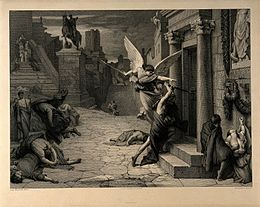| Antonine Plague | |
|---|---|
 The angel of death striking a door during the plague of Rome: an engraving by Levasseur after Jules-Elie Delaunay | |
| Disease | probably smallpox |
| First reported | Seleucia |
| Date | 165-180 |
Deaths | 5–10 million (estimated) |
| Fatality rate | 25 percent |

The Antonine Plague of AD 165 to 180, also known as the Plague of Galen (after Galen, the Greek physician who described it), was a prolonged and destructive epidemic,[1] which impacted the Roman Empire. It was possibly contracted and spread by soldiers who were returning from campaign in the Near East. Scholars generally believe the plague was smallpox,[1][2][3] although measles has also been suggested,[4][5][6][7] and recent genetic evidence strongly suggests that the most severe form of smallpox only arose in Europe much later.[8] In AD 169 the plague may have claimed the life of the Roman emperor Lucius Verus, who was co-regnant with Marcus Aurelius. These two emperors had risen to the throne by virtue of being adopted by the previous emperor, Antoninus Pius, and as a result, their family name, Antoninus, has become associated with the pandemic.
Ancient sources agree that the plague is likely to have appeared during the Roman siege of the Mesopotamian city of Seleucia in the winter of 165–166, during the Parthian campaign of Lucius Verus.[9] Ammianus Marcellinus reported that the plague spread to Gaul and to the legions along the Rhine. Eutropius stated that a large proportion of the empire's population died from this outbreak.[10] According to the contemporary Roman historian Cassius Dio, the disease broke out again 9 years later in 189 AD and caused up to 2,000 deaths a day in the city of Rome, 25% of those who were affected.[11] The total death count has been estimated at 5–10 million, roughly 10% of the population of the empire.[12][13] The disease was particularly deadly in the cities and in the Roman army.[14]
The Antonine plague occurred during the last years of what is called the Pax Romana, the high point in the influence, territorial control, and population of the Roman Empire. Historians differ in their opinions of the impact of the plague on the empire in the increasingly troubled eras after its appearance. Historians have noted similar plagues in the Han Empire of China during the mid-to-late 2nd century AD that caused devastating effects there, at a time when ancient Chinese historians claimed diplomatic contacts were made with what they perceived to be the Roman Empire. Based on archaeological records, Roman commercial activity in the Indian Ocean extending to the Indian subcontinent and Southeast Asia from ports of Roman Egypt seems to have suffered a major setback after the plague.
- ^ a b Duncan-Jones, Richard (2018). "The Antonine Plague Revisited". ARCTOS: Acta Philologica Fennica. LII: 44.
- ^ Brooke, John L. (2014). "A Global Antiquity, 500 BC–AD 542". Climate Change and the Course of Global History. Cambridget Core. pp. 317–349. doi:10.1017/CBO9781139050814.011. ISBN 9780521871648. Archived from the original on 29 September 2021. Retrieved 12 September 2021.
{{cite book}}:|website=ignored (help). Downloaded from Cambridge Core. - ^ Littman, R. J.; Littman, M. L. (1973). "Galen and the Antonine Plague". The American Journal of Philology. 94 (3): 243–255. doi:10.2307/293979. ISSN 0002-9475. JSTOR 293979. PMID 11616517.
- ^ Cunha, Cheston B.; Cunha, Burke A. (2008), Raoult, Didier; Drancourt, Michel (eds.), "Great Plagues of the Past and Remaining Questions", Paleomicrobiology: Past Human Infections, Berlin, Heidelberg: Springer, pp. 1–20, doi:10.1007/978-3-540-75855-6_1, ISBN 978-3-540-75855-6, PMC 7121113, retrieved 11 May 2022
- ^ "There is not enough evidence satisfactorily to identify the disease or diseases", concluded J. F. Gilliam in his summary (1961) of the written sources, with inconclusive Greek and Latin inscriptions, two groups of papyri and coinage.
- ^ At least one study finds the origin of measles post-dates the plague. See Furuse, Y.; Suzuki, A.; Oshitani, H. (2010). "Origin of the Measles Virus: Divergence from Rinderpest Virus Between the 11th and 12th Centuries". Virology Journal. 7: 52–55. doi:10.1186/1743-422X-7-52. PMC 2838858. PMID 20202190.
- ^ A more recent study finds that measles emerged well before the Antonine Plague. Düx, Ariane; Lequime, Sebastian; Patrono, Livia Victoria; Vrancken, Bram; Boral, Sengül; Gogarten, Jan F.; Hilbig, Antonia; Horst, David; Merkel, Kevin; Prepoint, Baptiste; Santibanez, Sabine (19 June 2020). "Measles virus and rinderpest virus divergence dated to the sixth century BCE". Science. 368 (6497): 1367–1370. Bibcode:2020Sci...368.1367D. doi:10.1126/science.aba9411. ISSN 0036-8075. PMC 7713999. PMID 32554594.
- ^ Newfield, Timothy P.; Duggan, Ana T.; Poinar, Hendrik (2022). "Smallpox's antiquity in doubt". Journal of Roman Archaeology. 35 (2): 897–913. doi:10.1017/S1047759422000290. S2CID 252341032.
- ^ Sicker, Martin (2000). "The Struggle over the Euphrates Frontier". The Pre-Islamic Middle East. Greenwood. p. 169. ISBN 0-275-96890-1.
- ^ Eutropius XXXI, 6.24.
- ^ Dio Cassius, LXXII 14.3–4; his book that would cover the plague under Marcus Aurelius is missing; the later outburst was the greatest of which the historian had knowledge.
- ^ "Reactions to Plague in the Ancient & Medieval World". World History Encyclopedia. Archived from the original on 23 April 2021. Retrieved 6 February 2021.
- ^ "Past pandemics that ravaged Europe". BBC News. 7 November 2005. Archived from the original on 7 October 2017. Retrieved 5 November 2008.
- ^ Smith, Christine A. (1996). "Plague in the Ancient World". The Student Historical Journal. Archived from the original on 6 August 2017. Retrieved 5 November 2008.